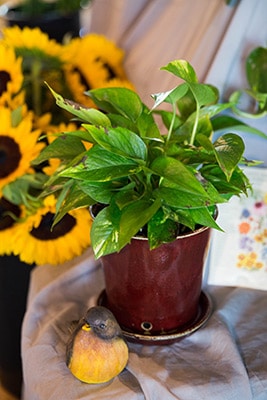Do you have a beloved house plant that seems to suffer in the winter? Or did you welcome a new member to your indoor garden this past holiday? We can help you keep your green friends healthy all season long.
Plant care changes from season to season, and your indoor plants are no exception. While every species requires different watering, heat, light, and humidity conditions, some rules are pretty constant across the board. Here’s a guide to getting your plants through the winter.

Pothos is a common indoor plant, popular for its hardiness. They typically need little water and little light to survive.
Watering. The vast majority of indoor plants go dormant in the winter, which means they need significantly less water. In fact, it’s best to let your plants dry out completely between watering from November through April. The top layer of soil will dry out pretty quickly in the winter, but make sure you test 1”-2” below the surface to see if you plant really needs a drink. Watering too much in the winter can lead to root rot, which will kill your plants off quicker than the cold.
Exception: If you have an indoor citrus plant or another moisture-loving plant. Keep their soil moist all year long.
Light. Most indoor plants are fine with moderate light, but during the winter they may need a change of scenery to get that. The daylight period is shorter, and the light comes at a lower angle. Relocate plants to west or south facing windows. Rotate the pots when you water to make sure they’re getting even distribution.Tip: If you feel like your plants aren’t getting enough light, it’s time to clean! Dust plants, and give windows a wash on the outside inside to maximize the amount of light hitting those leaves.
Temperature. Most indoor plants are like humans. We thrive at about 65-75 degrees during the day, and like it above 50 at night. But keeping your plants temperature consistent can be tricky. Make sure your plants are insulated from drafts, and not placed too close to radiators or heating vents.
Humidity. This is the trickiest part to get right. The humidity in your home in the winter usually falls to around 20%, while most plants prefer 50%. There are a couple remedies for this.
-
- A simple humidifier will do the trick. Just make sure your plants are placed close enough to benefit.
- Clustering plants together will help maintain humidity levels, since plants naturally give off moisture.
- Relocating plants to bathrooms or kitchens helps, since humidity tends to build in those rooms from showers, baths, and boiling water.
- DIY your way to ideal humidity for plants. Fill a shallow tray with water and add stones that rise above the water level. Place your plants on top of the stones – but make sure not to let them stand in the water!
Fertilizer. Don’t! While some indoor plants require fertilization, the winter isn’t the best time. Hold off until spring, when you start to see new growth.
Pruning and Repotting. Since winter growth can be leggy, feel free to gently prune your plants during this time. Woody plants like indoor trees are dormant during this time, which makes it a great time to repot. If you’re near us in the North East, this is best taken care of in March, right as temperatures start to rise again.
Pests. If you’re transferring an outdoor plant inside, you may be inviting some unwanted guests into your home. Mix a small amount of regular dish soap into water and lighting wipe down leaves to keep spider mites and other aphids from colonizing your indoor garden.
Do you have a specific plant you need a little help with? Let us know! We’ll do a write up on specific plant care in the coming weeks.




